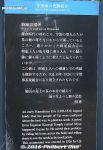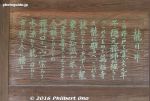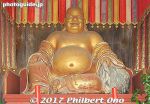 Last additions - Manpukuji Temple 萬福寺 Last additions - Manpukuji Temple 萬福寺 |

Pine treeJul 17, 2017
|
|

Very unusual thatched roof home near Manpukuji.Jul 17, 2017
|
|

Fire hydrant manhole. Near Manpukuji, Uji, Kyoto.Jul 17, 2017
|
|

"Curios" is an archaic term from the Meiji Period.Jul 17, 2017
|
|

About Koma no Ashikage-en Monument. According to legend, local people in Uji pondered over how to sow the seeds to grow tea.It was then Priest Myoe (明恵), from the Kegon-shu Buddhist Sect, came on horseback and trotted on the field saying, "Plant the seeds in my horse's hoof prints." This monument was built by Uji tea growers in 1926 to express their appreciation to Myoe.Jul 17, 2017
|
|

Koma no Ashikage-en Monument in front of the entrance to Manpukuji temple. This can be roughly translated as "Hoof Print Field Monument." 駒蹄影園跡碑This monument is part of the Japan Heritage designation for Uji tea history.Jul 17, 2017
|
|

Marijuana leaf (or maybe maple leaf) design on this street gutter cover near Manpukuji. Probably hemp leaves, commonly used for making cloth.Jul 17, 2017
|
|

Jul 17, 2017
|
|

WellJul 17, 2017
|
|

Buddhist picture print too.Jul 17, 2017
|
|

Sample printings.Jul 17, 2017
|
|

Woodblock for printing Buddhist scripture. Looks very worn out.Jul 17, 2017
|
|

Jul 17, 2017
|
|

Jul 17, 2017
|
|

Tetsugen Doko (1630-1682), one of Ingen's Japanese disciples, started the project to make these printing blocks still used today.Jul 17, 2017
|
|

Manpukuji also has a subtemple and treasure house called Hozoin (宝蔵院) noted for storing tens of thousands of woodblocks that are still used for printing Buddhist scriptures.Jul 17, 2017
|
|

Entrance to Hozoin.Jul 17, 2017
|
|

Jul 17, 2017
|
|

Jul 17, 2017
|
|

Jul 17, 2017
|
|

Jul 17, 2017
|
|

Manpukuji also has a subtemple and treasure house called Hozoin (宝蔵院) noted for storing tens of thousands of woodblocks used for printing Buddhist scriptures.Jul 17, 2017
|
|

Lotus in a pot at Manpukuji temple.Jul 17, 2017
|
|

Little pine cones at Manpukuji.Jul 17, 2017
|
|

Dessert. One of the best meals I ever had in Japan. Advance reservations are required. It's not a walk-in restaurant. More info photos in Japanese: https://www.obakusan.or.jp/eat/Jul 17, 2017
|
|

Rice was finally served at the end with pickles.Jul 17, 2017
|
|

Jul 17, 2017
|
|

Jul 17, 2017
|
|

Fucha ryori has no fish nor meat.Jul 17, 2017
|
|

Fucha ryori became very popular after it was first introduced in Japan. No wonder. It looks exotic and tastes absolutely delicious. Salad.Jul 17, 2017
|
|

Appetizers of our full-course, Chinese-style religious vegetarian cuisine at Icho-an. This plate was for four people. Very different, very colorful, and such a unique taste and deliciousness that I've never had before.Fucha ryori is healthy too. Well worth the ¥5,000 which I first thought was quite pricey for a religious meal with no meat. Got stuffed and we could take home some food too.Jul 17, 2017
|
|

Inside Icho-an. We could immediately tell that it was Chinese since the food was served on a turntable (Lazy Susan) which you can see in the photo.(This photo was taken after we finished lunch.)Jul 17, 2017
|
|

Icho-an restaurant serves Chinese-style shojin-ryori (religious vegetarian cuisine) called fucha-ryori (普茶料理). This is another thing about Manpukuji. The sect's founder Ingen helped to spread Chinese cuisine in Japan from the 17th c.Jul 17, 2017
|
|

Near the Sanmon Gate is this entrance to Icho-an restaurant. 銀杏庵Jul 17, 2017
|
|

A simple bento (box lunch) fucha ryori at Manpukuji temple, Uji, Kyoto 普茶料理Jul 17, 2017
|
|

"Obaku-san Fucha Ryori" bento-type (box lunch) fucha ryori for our large tour group. It costs around ¥3,000.Jul 17, 2017
|
|

On my second visit to Manpukuji, I went with a group of foreigners and had lunch at the temple's restaurant Oryokaku (黄龍閣) serving Chinese-style shojin-ryori (religious vegetarian cuisine) called fucha-ryori (普茶料理).Jul 17, 2017
|
|

Plum blossoms.Jul 17, 2017
|
|

Women cleaning the sliding lattice doors before repapering.Jul 17, 2017
|
|

Prayer tablets (ema)Jul 17, 2017
|
|

About the Bell TowerJul 17, 2017
|
|

Bell tower (Important Cultural Property)Jul 17, 2017
|
|

伽藍堂Jul 17, 2017
|
|

伽藍堂 (Important Cultural Property)Jul 17, 2017
|
|

Jul 17, 2017
|
|

Manpukuji's famous wooden fish board used like a gong to indicate the time. 魚梆Jul 17, 2017
|
|

Manpukuji's famous fish board. 魚梆Jul 17, 2017
|
|

Jul 17, 2017
|
|

About Hatto Hall. Jul 17, 2017
|
|

Hatto Hall's bell-shaped window.Jul 17, 2017
|
|

Jul 17, 2017
|
|

Behind the Daiohoden Hall is Hatto Hall (Important Cultural Property) where Buddhist lectures are held. 法堂(はっとう)Jul 17, 2017
|
|

Rear view of Daiohoden Hall.Jul 17, 2017
|
|

Rear view of Daiohoden Hall.Jul 17, 2017
|
|

Jul 17, 2017
|
|

Jul 17, 2017
|
|

Jul 17, 2017
|
|

Jul 17, 2017
|
|

Jul 17, 2017
|
|

Jul 17, 2017
|
|

Each arhat has a name.Jul 17, 2017
|
|

Daiohoden Hall also has statues of the Eighteen Arhats. 十八羅漢像They are the original followers of the Buddha who have reached the state of Nirvana and are free of worldly desires. Jul 17, 2017
|
|

These mats on the floor are not for sitting. The priests stand behind the mats and chant.Jul 17, 2017
|
|

Side view of the Shaka Nyorai.Jul 17, 2017
|
|

Chinese wooden fish drum for beating during prayers.Jul 17, 2017
|
|

Jul 17, 2017
|
|

Shaka Nyorai or Gautama Buddha, founder of Buddhism. 釈迦如来座像Jul 17, 2017
|
|

Jul 17, 2017
|
|

Altar inside Daiohoden Hall, Manpukuji's main temple. It worships a sitting Shaka Nyorai or Gautama Buddha. 大雄寶殿(だうおうほうでん)Jul 17, 2017
|
|

In front of Daiohoden Hall.Jul 17, 2017
|
|

Daiohoden Hall entrance.Jul 17, 2017
|
|

Round window at Daiohoden Hall.Jul 17, 2017
|
|

Chinese-style incense burner.Jul 17, 2017
|
|

Daiohoden Hall (Important Cultural Property), Manpukuji's main temple. 大雄寶殿(だうおうほうでん)Jul 17, 2017
|
|

About Daiohoden Hall.Jul 17, 2017
|
|

Daiohoden Hall (Important Cultural Property), Manpukuji's main worship hall or temple. 大雄寶殿(だうおうほうでん)Jul 17, 2017
|
|

Jul 17, 2017
|
|

Daiohoden Hall roof.Jul 17, 2017
|
|

Jul 17, 2017
|
|

Corridor to Daiohoden Hall.Jul 17, 2017
|
|

Jul 17, 2017
|
|

Jul 17, 2017
|
|

Jul 17, 2017
|
|

Jul 17, 2017
|
|

Jul 17, 2017
|
|

Jul 17, 2017
|
|

Jul 17, 2017
|
|

Jul 17, 2017
|
|

Jul 17, 2017
|
|

Jul 17, 2017
|
|

Jul 17, 2017
|
|

Statue behind the Hotei statue.Jul 17, 2017
|
|

Our Manpukuji priest guide spoke through our interpreter.Jul 17, 2017
|
|

Inside Manpukuji's Tennoden Hall is Hotei, one of the Seven Gods of Good Fortune. 天王殿(てんのうでん)、弥勒菩薩(布袋)Jul 17, 2017
|
|

Our Manpukuji priest guide admits his resemblance to Hotei and kindly posed next to it.Jul 17, 2017
|
|

Inside the Tennoden Hall is Hotei, one of the Seven Gods of Good Fortune. 天王殿(てんのうでん)、弥勒菩薩(布袋)Jul 17, 2017
|
|

Jul 17, 2017
|
|

Tennoden Hall (Important Cultural Property). 天王殿(てんのうでん)Jul 17, 2017
|
|

Jul 17, 2017
|
|

Manpukuji temple bell in a corridor.Jul 17, 2017
|
|

Manpukuji temple bell in a corridor.Jul 17, 2017
|
|

Manpukuji corridor lanterns.Jul 17, 2017
|
|

Jul 17, 2017
|
|

石碑Jul 17, 2017
|
|

寿塔Jul 17, 2017
|
|

Manpukuji has a lot of covered corridors linking the major buildings.Jul 17, 2017
|
|

The big Sanmon Gate in the background.Jul 17, 2017
|
|

Kaizan-do HallJul 17, 2017
|
|

Altar inside the Kaizan-do Hall.Jul 17, 2017
|
|

Jul 17, 2017
|
|

Chinese design on the railing. Temple buildings are in Ming-style. Many buildings are Important Cultural Properties, but no National Treasures. 卍崩しのデザインJul 17, 2017
|
|

Chinese-style architecture is obvious with the roof corners curling upward.Jul 17, 2017
|
|

Manpukuji's Kaizan-do Hall (Important Cultural Property) where sect founder Yinyuan Longqi (Ingen) is worshipped. 開山堂(かいさんどう)Jul 17, 2017
|
|

Very fine roof.Jul 17, 2017
|
|

Karahafu roof gableJul 17, 2017
|
|

Karahafu roof gableJul 17, 2017
|
|

Jul 17, 2017
|
|

Before going to Tennoden Hall, we turned left to this small gate leading to Kaizan-do Hall.Jul 17, 2017
|
|

Jul 17, 2017
|
|

From Sanmon Gate, path to Tennoden Hall. The path is modeled after dragon scales.Jul 17, 2017
|
|

From Sanmon Gate, path to Tennoden Hall. The path is modeled after dragon scales.Jul 17, 2017
|
|

From Sanmon Gate, path to Tennoden Hall. The path is modeled after dragon scales.Jul 17, 2017
|
|

The Sanmon main gate (exit side). 三門(さんもん)Jul 17, 2017
|
|

At the Sanmon Gate, pay the admission to enter the temple. It's a very interesting temple, but they don't really have English explanations.Jul 17, 2017
|
|

Sanmon main gate. 三門(さんもん)Jul 17, 2017
|
|

The Sanmon main gate (Important Cultural Property). 三門(さんもん)Jul 17, 2017
|
|

Jul 17, 2017
|
|

Lotus pond in front of Sanmon Gate. 放生池Jul 17, 2017
|
|

Manpukuji (萬福寺) is a large temple complex and headquarters of a Chinese Zen sect (Obaku-shu). It's one of the Big Three Zen sects in Japan (besides Soto and Rinzai).The founder was Chinese Zen master Yinyuan Longqi (Ingen) from Fujien Province in China who came to Japan via Nagasaki in 1654. Manpukuji (or Mampukuji) is part of the Japan Heritage for Uji tea history. A short walk from Obaku Station on the JR Nara Line and Keihan Uji Line. Jul 17, 2017
|
|

Chinese-style Somon Gate (Important Cultural Property), the first entrance to Manpukuji. It's a quite a large temple complex with numerous buildings. A few of the major buildings are open to the public. 総門(そうもん)Jul 17, 2017
|
|
|
|
|
|